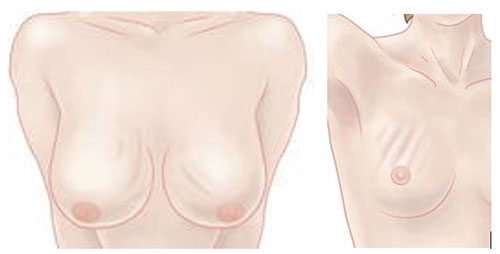Breast implants rippling can be a frustrating issue for many women, regardless of width or place. This issue occurs when the implant develops visible folds or wrinkles during breast surgery, causing an uneven appearance. Rippling is more common with saline implants but can also place an issue on silicone ones. Factors like implant placement, skin thickness, and implant size contribute to this problem. Understanding the causes and solutions can help you make informed decisions about your breast augmentation journey, including implant surgery, planning implant placement, implant position, and implant leakage. Whether you’re considering implants or already have them, knowing how to minimize rippling is crucial for achieving natural-looking results.
Key Takeaways
-
Understand Rippling: Rippling is a common issue with breast implants, where the surface appears wavy or uneven, often due to implant type or placement.
-
Root Causes Matter: Factors like thin skin, minimal breast tissue, and implant underfilling can contribute to rippling. Knowing these helps in prevention.
-
Choose Implants Wisely: Opt for high-quality implants and consider silicone over saline as they tend to ripple less.
-
Placement is Crucial: Submuscular placement (under the muscle) generally reduces the risk of rippling compared to subglandular placement (over the muscle).
-
Prevention Strategies: Surgeons can employ techniques such as using textured implants or adjusting pocket dimensions to minimize rippling risks.
-
Seek Expertise: Always choose a board-certified surgeon with extensive experience in breast augmentation to ensure optimal outcomes and address rippling effectively.
Understanding Rippling
Definition
Breast implant rippling refers to the formation of visible wrinkles or waves on the surface of breast implants. These ripples can appear under the skin, especially when the skin is thin. Silicone and saline implants are both susceptible to this issue. Rippling often becomes noticeable in certain positions or movements.
Visibility
Rippling is more visible in patients with less natural breast tissue. Thin skin also makes implant ripple more apparent. The upper and outer parts of the breast are common areas where rippling shows up. Wearing tight clothing can make ripples even more noticeable.
Aesthetic Impact
Rippling affects the overall look of the breasts. Many patients feel self-conscious about these visible waves. They may avoid certain types of clothing or activities to hide the ripples. This can lead to dissatisfaction with their appearance.
Patient Satisfaction
Patient satisfaction drops when rippling occurs. Many patients expect smooth, natural-looking results from their implants. Visible ripples can be disappointing and frustrating. Some may seek additional surgeries to correct the problem, which adds to their stress and financial burden.
Importance for Recipients
Understanding rippling is crucial for anyone considering breast implants. Knowing the risks helps patients make informed decisions. They can discuss potential outcomes with their surgeons and choose options that minimize rippling.
Root Causes of Rippling
Insufficient Tissue Coverage
Insufficient breast tissue coverage can lead to rippling. Thin skin or minimal breast tissue cannot adequately cover the implant. This lack of coverage makes the implant edges more noticeable. Women with less natural breast tissue are at higher risk. The skin and tissue cannot hide the implant, resulting in visible wrinkles or ripples on the surface.
Implant Size and Capsule Sizing
The size of the implant plays a crucial role. Larger implants are more likely to ripple. They stretch the skin and tissue more than smaller ones. This stretching can cause visible wrinkling. Proper capsule sizing is also essential. If the pocket made for the implant is too large, it can lead to movement and rippling.
Saline Implant Under-Filling
Saline implants can suffer from under-filling issues. Under-filled implants do not have enough saline solution inside them. This lack of filling creates folds and wrinkles in the implant shell. These folds become visible through the skin, causing rippling.
Valve Failure
Valve failure is another problem with saline implants. The valve controls the amount of saline inside the implant. If it fails, saline can leak out, causing the implant to deflate partially. This partial deflation leads to visible wrinkles on the breast surface.

Cleavage Concerns
Rippling often occurs near the cleavage area. The skin in this region is usually thinner, making it more prone to showing ripples. Women seeking larger cleavage may opt for bigger implants, increasing their risk of rippling in this area.
Choosing Implants Wisely
Implant Size
Selecting the right implant size is crucial. Breast augmentation patients should choose implants that fit their body. A larger implant may cause rippling if it does not match the chest width.
Implant sizing involves measuring the chest and determining the volume needed. Surgeons can help patients pick a size that looks natural and reduces risks.
Implant Profile
The profile of an implant affects its appearance and risk of rippling. Lower profile implants are wider and flatter, while high-profile ones are narrower and more projecting.
Choosing the correct profile depends on the patient’s body type. Lower profile implants often suit broader chests, reducing the chance of rippling.
Implant Types
There are different types of breast implants. Smooth implants have a softer feel but might move around more. Textured implants stick better to tissue, reducing movement.
Each type has pros and cons. Consulting with a surgeon helps patients understand which type suits them best.
Advanced Technology
Advancements in implant technology have reduced rippling risks. Newer implants mimic natural breast tissue more closely.
For example, cohesive gel implants hold their shape better than traditional breast implants. These innovations provide beautiful breast augmentation results with fewer complications.
Surgeon Consultation
A consultation with a skilled surgeon is essential. Surgeons can explain the differences between various implants and help make informed choices.
During a breast augmentation consultation, surgeons discuss patient goals and anatomy. This ensures that the chosen implant will meet expectations and minimize risks like rippling.
Placement Techniques
The placement of breast implants also plays a role in preventing rippling. Subglandular breast implants are placed above the muscle, while submuscular ones go below it.
Submuscular placement often reduces rippling since the muscle provides extra coverage for the implant edges. Surgeons can recommend the best technique based on individual cases.
Revision Surgery
etimes, patients may need implant revision surgery to correct issues like rippling. This procedure replaces or adjusts existing implants to improve appearance and comfort.
Revision surgery can address problems from previous augmentations. It offers a solution for those experiencing complications with their current implants.
Importance of Implant Placement
Muscle Placement
Placing implants under the muscle can reduce rippling. The muscle provides a layer of coverage over the implant. This extra layer hides any wrinkles or folds in the implant surface. Submuscular placement is often recommended for those with thin breast tissue.
Rippling Risk
Submuscular and subglandular placements have different risks. Submuscular placement involves placing the implant under the chest muscle. This reduces visible rippling but can be more painful initially. Subglandular placement puts the implant above the muscle, directly under the breast tissue. This method may result in more visible rippling, especially if there is little natural breast tissue.
Surgical Technique
The surgeon’s technique plays a key role in implant placement. Proper planning and execution can optimize aesthetic outcomes. Surgeons must choose the right implant size and profile for each patient. They also need to create an appropriate implant pocket to ensure a good fit.
Implant Profile
Implant profile affects how noticeable rippling will be. High-profile implants project more from the chest, which might hide ripples better. Low-profile implants spread out more, potentially increasing the risk of visible rippling.
Implant Surface Wrinkles
Implants can develop surface wrinkles over time. These wrinkles are more noticeable in certain placements. Choosing textured implants can sometimes help because they adhere better to surrounding tissues.
Saline Versus Silicone
Rippling Propensity
Saline breast implants are more likely to cause rippling. The saline solution inside the implant can move around. This movement creates visible waves on the skin surface.
Silicone implants, especially those filled with highly cohesive gel, have a lower chance of rippling. The gel inside these implants is thicker and less likely to shift. Highly cohesive silicone gel implants remain stable and maintain their shape better.
Benefits of Silicone
Highly cohesive silicone gel implants offer several benefits. One major advantage is their reduced risk of rippling. The thick gel inside these implants mimics natural breast tissue closely.
These implants also feel more natural to the touch. They provide a smoother appearance under the skin. Silicone implants are often preferred for their realistic look and feel.
Choosing Based on Risk Factors
Choosing between saline and silicone depends on individual risk factors. Patients with thin breast tissue may experience more rippling with saline implants. Those with thicker tissue might not notice as much difference.
Surgeons consider body type, skin elasticity, and existing breast tissue when recommending an implant type. Saline breast implants might be suitable for some, while others benefit more from silicone.
Cost Considerations
Silicone implants are generally more expensive than saline ones. This cost difference is due to the materials used and the manufacturing process. Patients must weigh the price against the benefits.
Insurance coverage can vary based on the type of implant and reason for surgery. It’s important to check with providers about what costs are covered.
Safety and Maintenance
Both saline and silicone implants have safety profiles approved by health authorities. Regular check-ups are necessary to monitor implant condition. Silicone implants may require MRI scans to detect any silent ruptures.
Patients should follow their surgeon’s advice for maintenance and care. Proper post-surgery care can minimize complications and prolong implant life.
Surgeon Strategies for Prevention
Surgical Techniques
Surgeons use various techniques to prevent breast implant rippling. One key method is precise pocket creation. The pocket is the space where the implant sits. Creating this space accurately helps in achieving a smooth surface and reduces rippling.
Another technique involves choosing the correct implant size and shape. Surgeons consider the patient’s body frame and desired breast projection. By matching the implant to the body’s natural contours, they can minimize rippling.
Surgeon Experience
Experience plays a crucial role in preventing rippling. Skilled surgeons plan surgeries meticulously. They assess factors like skin thickness and tissue quality. This careful planning helps in selecting the right implant type and placement.
Experienced surgeons are also adept at handling complications. They know how to adjust their techniques based on individual patient needs. Their expertise ensures better outcomes and less risk of rippling.
Post-Operative Care
Post-operative care is vital in maintaining implant integrity. Proper care helps reduce the chances of rippling over time. Surgeons often provide detailed instructions for recovery.
Patients may need to wear support garments. These garments help in keeping the implants in place during healing. Following these guidelines can make a significant difference.
Corrective Options for Rippling
Fat Transfer
Fat transfer can help camouflage implant rippling. Surgeons use liposuction to remove fat from other parts of the body. They then inject this fat into the breast area. This method adds natural tissue coverage over the implants, reducing visible ripples.
Patients often prefer this option because it uses their own body fat. It provides a more natural look and feel. However, not all patients are candidates for fat transfer. The surgeon will evaluate each case individually.
Implant Revision Surgery
Breast implant revision surgery addresses the underlying causes of rippling. During this procedure, surgeons can correct issues with the implant or its placement. This surgery often involves removing and replacing the implants.
The surgeon may also adjust the pocket where the implant sits. This adjustment can help reduce movement and minimize ripples. Revision surgery is usually more complex than the initial procedure. It requires a skilled and experienced surgeon.
Changing Implant Type
Changing the type of implant can also correct rippling. Silicone implants are less likely to ripple compared to saline implants. They have a thicker gel that maintains its shape better.
Switching from saline to silicone may reduce visible ripples. Some patients may choose highly cohesive silicone implants, also known as “gummy bear” implants. These implants hold their shape well and offer a firmer feel.
Adjusting Implant Placement
Adjusting the placement of the implant can be another solution. Implants can be placed either above or below the chest muscle. Submuscular placement (below the muscle) often reduces rippling.
This method provides more tissue coverage over the implant. It hides ripples better than subglandular placement (above the muscle). Patients should discuss these options with their surgeon to determine the best approach.
Combining Methods
etimes, combining multiple methods yields better results. For example, a surgeon might use both fat transfer and implant revision surgery. This combination can offer a more comprehensive solution to implant ripples.
Each patient’s situation is unique. A personalized approach ensures better outcomes and higher patient satisfaction.
Finding a Reliable Surgeon
Board-Certified Surgeons
Selecting a board-certified plastic surgeon is crucial. Certification ensures the surgeon has completed rigorous training. They should have experience in breast augmentation and reconstruction surgery. This background helps manage complications like rippling.
Reviewing Before-and-After Photos
Before choosing a surgeon, review their before-and-after photos. Look for patients with similar body types and concerns. These photos provide insight into the surgeon’s skill and expected results. They also help set realistic expectations.
Patient-Surgeon Communication
Effective communication between patient and surgeon is essential. Discuss your goals and concerns in detail. Ask about potential risks and outcomes. A good surgeon will listen and provide honest feedback.
Importance of Experience
Experienced surgeons are more likely to achieve satisfactory results. They understand the complexities of breast surgery. Their expertise helps them handle issues like skin elasticity and implant placement.
Setting Realistic Expectations
Discussing expectations with your surgeon is vital. Understand that perfect results are not always possible. Knowing the potential cons and limitations can help you make an informed decision.
Addressing Rippling Issues
Ask your surgeon about strategies to minimize rippling. Techniques may include using textured implants or placing them under the muscle. Surgeons may also recommend fat grafting to improve appearance.
Post-Surgery Care
Follow your surgeon’s post-surgery instructions carefully. Wearing a surgical bra can support healing. Proper care reduces complications and improves overall results.
Closing Thoughts
You’ve now got a solid grasp on breast implant rippling and how to tackle it. From understanding the causes to choosing the right implants and placement, you’re better equipped to make informed decisions.
Don’t settle for less. Find a reliable surgeon who can guide you through this journey. Ready to take the next step? Schedule a consultation and ensure your peace of mind.
Frequently Asked Questions
What is breast implant rippling?
Breast implant rippling refers to visible or palpable folds and wrinkles on the surface of breast implants, which can affect the appearance and feel of the breasts.
What causes breast implant rippling?
Rippling can be caused by factors such as thin breast tissue, underfilled implants, or placement above the muscle. It’s essential to discuss these risks with your surgeon.
How can I choose implants to minimize rippling?
Opt for silicone implants over saline, as they tend to ripple less. Also, consider implants with a textured surface and appropriate size to suit your body.
Why is implant placement important in preventing rippling?
Placing implants under the muscle provides better coverage and reduces the chances of rippling. Always consult with an experienced surgeon about the best placement for you.
Which type of implant is less likely to ripple in breast augmentation procedures: saline or silicone?
Silicone implants are generally less likely to ripple compared to saline implants due to their cohesive gel filling that maintains shape better.
Can a skilled surgeon prevent breast implant rippling?
Yes, an experienced surgeon can use techniques such as selecting the right implant type, proper placement, and ensuring adequate tissue coverage to minimize the risk of rippling.
What are my options if I experience breast implant rippling with a cosmetic surgeon, choice of place, and tissues?
Corrective options include fat grafting, switching to silicone implants, or adjusting implant placement. Consult with a board-certified plastic surgeon for personalized solutions.





